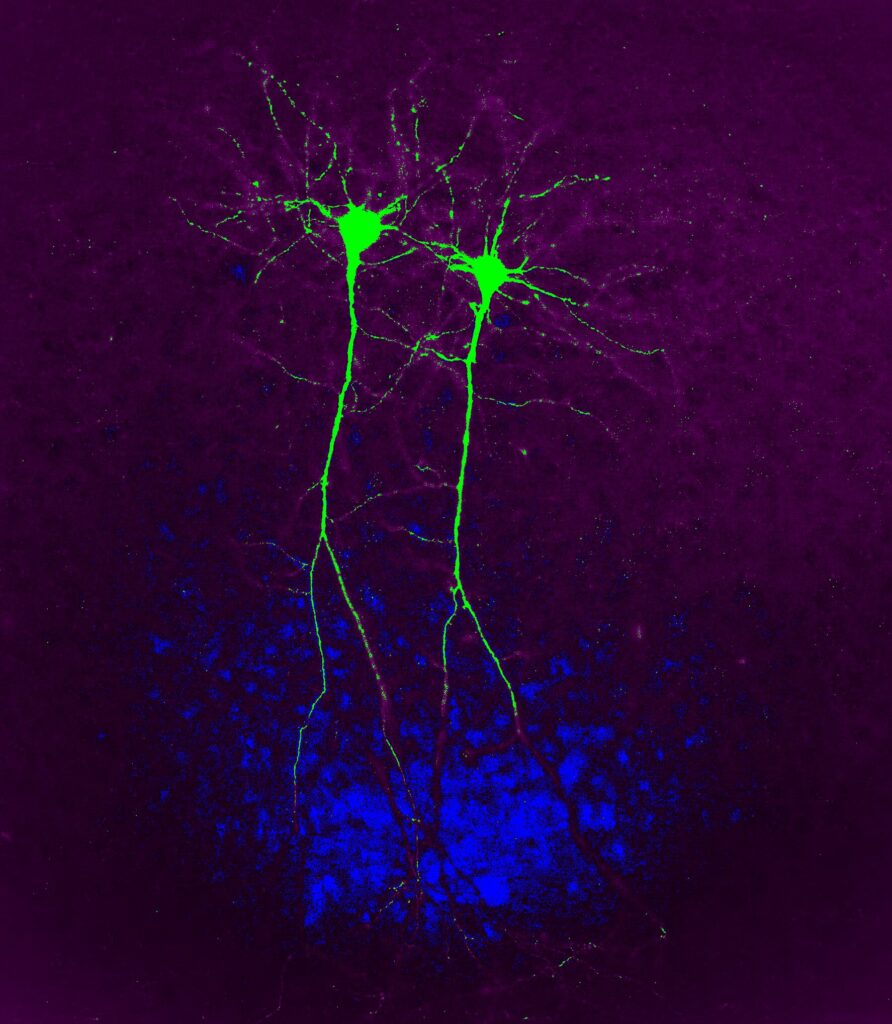Two dancing neurons win 3. prize in the DNRF’s Photo Competition 2023
“This picture shows two neurons in the brain. To me it also shows two couples dancing in a dim light corner of a room,” said postdoc Meet Jariwala from Biotech Research and Innovation Centre (BRIC) about his photo that won third prize in the DNRF Photo Competition 2023.

“This couple also has some kind of connection to my personal story as well. It gives me a total glimpse of my life, so far, and it reflects how much I have progressed over time” he continued.
“The image also inspires me a lot routinely. Times can be tough in science, and they come with dark phases, but persistence and giving my best during such times re-motivates me. In the same way as these couple neurons who are dancing by themselves in a dark corner, full of energy. I feel the same vibe.”
Meet Jariwala works with neuropsychiatric research, the branch of psychiatry that investigates the links between mental illness and organic disease of the brain – and his focus is the “schizophrenia mouse model,” which means that he is studying neurons that are active in a mouse model which has schizophrenia-like symptoms. Or put in another way, they mimic human symptoms in the mouse.
Looking for the responsible genes
“Neurons are a specific kind of cells in our brain. In our bodies, the main unit of life is a cell. But in brains the cells are known as neurons,” explained Jariwala and continued:
“The neurons in the picture are long-range neurons. It means they go to different parts of the brain. They pass information from one region to another region in the brain as a kind of relay race where one runner provides another runner with a baton and then runs to the other side. Neurons do the same. They are helpful in delivering information. We are always surrounded by various types of stimuli or sensations. And the neurons help our bodies to process these sensations and deliver the messages to perform, to act, or to move our bodies in a way that it has been processed.”
“The two neurons in the picture are colored because we have encoded a fluorescence in the neurons. So, when the neurons are active it shows fluorescence. These neurons are in the cortex, the brain’s outer layer.”
Jariwala explained that they use this method to identify the key brain regions involved with schizophrenia-like behavior.
“Previous studies have shown that deletion of specific genes is responsible for causing mental disorders. In our lab, we try to understand the genetic level of some neuropsychiatric diseases and identify key candidate genes that are responsible exclusively for schizophrenia. We can’t do this study on humans, so we must do it in a more basic model in a mouse brain which is very similar to the human brain.”
Childhood thriller movies were an early inspiration.
Jariwala’s motivation for going into the field of neuropsychiatry and neural circuits goes back to his childhood:
“As a child I used to watch thriller movies where one of the characters could be someone with a neuropsychiatric disorder. And I was always curious about what really made them different and why they were always presented in a negative way. And I always thought that maybe these people need some help. And I thought that maybe in the future I could help them in some way.”
And when Jariwala later in his youth was introduced to neurons, everything fell into place: “The neurons looked so elegant to me. Like a tree with all its branches. So, I enjoy studying the cells through a microscope where I see really beautiful brain regions, structures, and shapes of the cells. And I also like the old saying: ‘I believe, what I see. ‘I mean sometimes can already see in the behavior of animals or in the microscope that the neurons etc. have different structures and that gives me more information than anything else.”
Even though studying neurons in mice can be far away from the real life and human patients Jariwala believes that working in BRIC brings him a step closer to the patients because the scientists work in close collaboration with the hospitals like the Rigshospitalet, a highly specialized hospital in Denmark, or from a collaborating lab, where we get human tissue samples.
Furthermore, working with mice is to Jariwala, in many ways like working with humans. “I learn more about humans while working with the mice because they require the same attention and care as human beings, so yes, I relate to this a lot.”
A noble goal
“So, once we identify the genes that cause these neuropsychiatric disorders, the end product would be to rescue these genes or to find drug therapeutics that could cure, or at least alleviate the symptoms of, such neuropsychiatric disorders. Maybe we are not that far from creating a medicine that can specifically help patients with schizophrenia,” explained Jariwala.
“And if you go back to my initial motivation in trying to help a person with a mental disorder, my research has progressed in that same direction. And in the future, I hope that I can contribute with a drug that, together with care and counseling, really can help people with mental disorders.”
